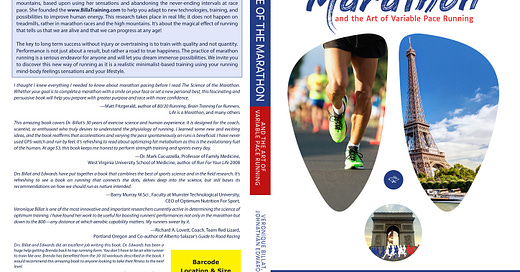Book: The Science of the Marathon
And the Art of Variable Pace Running by Veronique Billat PhD and Johnathan Edwards MD
In marathon running, we often hear, above all, make it to the finish line! Life is not only about racing and accepting the medal, but it’s true that racing adds spice to our lives.
This book is an ode to running and racing, offering the latest scientific innovations put into practice. Our goals are:
To help you reach your potential in the running.
Save you time.
Add more pleasure to running.
And to show that running can be done without suffering.
The genesis of The Science of the Marathon came about when I met Dr. Veronique Billat in a correspondence about the 105-year-old French cyclist she was working with, Robert Marchand. I wrote to her in French, and she said that an American had never communicated with her in French. Eventually, she asked me to write the English version of her book, The Marathon Revolution.
Contrary to popular belief, running and training for a marathon can be fun and without injury. Training for a marathon absorbs a lot of time. So why do we do it? Running is about many things, but it’s mainly about transformation. Most are not born to run; we are either too short, too tall, or not athletic.
It’s about the Journey
People new to running approach their first marathon with trepidation and fear, along with transforming hope. It’s the journey that changes the person forever. Several popular running books tell you to start slow, stay at one pace, and finish if possible! Humans were never designed to run at one pace. We call this running constant-paced training. Humans instinctively vary the pace; if we let it happen naturally, we can run for a lifetime.
Variable Paced Running
Varying the speed or pace is exactly the opposite of running at a constant or similar speed. It sounds easy enough, but most are taught to run at a target pace. When the wrong pace is chosen, several things are sure to occur:
Cramps
Fatigue
Hitting the wall at the 20th mile
Slowing of the pace
and Not finishing the marathon
An intriguing aspect of varying the pace is that homeostasis is maintained; you will never come close to bonking, especially at the mythic 23rd mile. Many runners try to maintain a constant pace that is too fast. When a runner attempts to hold an overly ambitious target pace, this results in fatigue and cracking and inevitably leads to the runner achieving a pace much below the runner’s goal.




